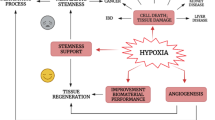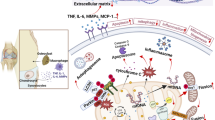Abstract
The DNA polymeric molecules polydeoxynucleotide (PDRN) and polynucleotide (PN) can be used as new alternative treatment for osteoarthritis (OA); however, the underlying mechanisms are not fully understood. In this study, we investigated the effect of PDRN and PN on gene-expression profiles in a cell model of OA using transcriptome analysis. Under hypoxic conditions, human chondrosarcoma cells were stressed for 24 h in the presence of interleukin (IL)-1β and subsequently treated with PDRN, PN, or hyaluronic acid (HA) for another 24 h, followed by transcriptome analysis. The results of the transcriptome study comprising differentially expressed genes were analyzed using the Database of Annotation Visualization and Integrated Discovery program, which yielded Kyoto Encyclopedia of Genes and Genomes pathways. Toll-like receptor (TLR)- and nucleotide-binding oligomerization domain-like receptor (NLR)-signaling pathways were related between the IL-1β group and the group treated with DNA polymeric molecules. The genes involved in the TLR- and NLR-signaling pathways were validated using real-time quantitative polymerase chain reaction and western blot. Among these genes, IL-6, IL-1β, IL-8, and chemokine (C-C motif) ligand 3 were dramatically upregulated in the IL-1β group, but significantly downregulated in the group treated with DNA polymeric molecules. Specifically, PN treatment resulted in a greater decrease in the expression of these genes as compared with PDRN treatment. Both PDRN and PN treatments were involved in the anti-inflammatory response associated with OA progression, with PN treatment exhibiting additional anti-inflammatory properties relative to PDRN treatment. These results provide insight into potential therapeutic approaches involving PDRN and PN treatment of OA.







Similar content being viewed by others
Abbreviations
- OA:
-
osteoarthritis
- PDRN:
-
polydeoxynucleotide
- PN:
-
polynucleotide
- NOD:
-
nucleotide-binding oligomerization domain
- NLR:
-
nucleotide-binding oligomerization domain-like receptor
- HA:
-
hyaluronic acid
- PBS:
-
phosphate-buffered saline
- DMEM-HG:
-
dulbecco’s modified Eagle medium-high glucose
- DAVID:
-
Database for Annotation, Visualization, and Integrated Discovery
- KEGG:
-
Kyoto Encyclopedia of Genes and Genomes
- RT-PCR:
-
reverse transcription polymerase chain reaction
- qRT-PCR:
-
real-time quantitative PCR
- IL:
-
interleukin
- CCL:
-
chemokine (C-C motif) ligand
- CXCL:
-
C-X-C motif chemokine
- LBP:
-
lipopolysaccharide-binding protein
- TLR:
-
toll-like receptor
- TNFAIP3:
-
tumor necrosis factor alpha-induced protein 3
- CASP:
-
caspase apoptosis-related cysteine peptidase
- GAPDH:
-
glyceraldehyde-3-phosphate dehydrogenase
References
Malfait, A.M. 2016. Osteoarthritis year in review 2015: biology. Osteoarthritis and Cartilage 24 (1): 21–26.
Civinini, R., L. Nistri, C. Martini, B. Redl, G. Ristori, and M. Innocenti. 2013. Growth factors in the treatment of early osteoarthritis. Clin Cases Miner Bone Metab 10 (1): 26–29.
Giarratana, L.S., B.M. Marelli, C. Crapanzano, et al. 2014. A randomized double-blind clinical trial on the treatment of knee osteoarthritis: the efficacy of polynucleotides compared to standard hyaluronian viscosupplementation. The Knee 21 (3): 661–668.
Bonnet, C.S., and D.A. Walsh. 2005. Osteoarthritis, angiogenesis and inflammation. Rheumatology (Oxford) 44 (1): 7–16.
Orlowsky, E.W., and V.B. Kraus. 2015. The role of innate immunity in osteoarthritis: when our first line of defense goes on the offensive. The Journal of Rheumatology 42 (3): 363–371.
Vincent, T.L. 2013. Targeting mechanotransduction pathways in osteoarthritis: a focus on the pericellular matrix. Current Opinion in Pharmacology 13 (3): 449–454.
Torrero, J.I., and C. Martinez. 2015. New developments in the treatment of osteoarthritis—focus on biologic agents. Open Access Rheumatol 7: 33–43.
Liu-Bryan, R., and R. Terkeltaub. 2015. Emerging regulators of the inflammatory process in osteoarthritis. Nature Reviews Rheumatology 11 (1): 35–44.
Wenham, C.Y., and P.G. Conaghan. 2010. The role of synovitis in osteoarthritis. Ther Adv Musculoskelet Dis 2 (6): 349–359.
Kapoor, M., J. Martel-Pelletier, D. Lajeunesse, J.P. Pelletier, and H. Fahmi. 2011. Role of proinflammatory cytokines in the pathophysiology of osteoarthritis. Nature Reviews Rheumatology 7 (1): 33–42.
Ortolano, G.A., and B. Wenz. 2014. A review of the pathogenesis of osteoarthritis and the use of intra-articular platelet therapy for joint disease in animals and humans. Bone and Tissue Regeneration Insights 5: 1–13.
Thellung, S., T. Florio, A. Maragliano, G. Cattarini, and G. Schettini. 1999. Polydeoxyribonucleotides enhance the proliferation of human skin fibroblasts: involvement of A2 purinergic receptor subtypes. Life Sciences 64 (18): 1661–1674.
Jacobson, K.A., and Z.G. Gao. 2006. Adenosine receptors as therapeutic targets. Nature Reviews. Drug Discovery 5 (3): 247–264.
Linden, J. 2005. Adenosine in tissue protection and tissue regeneration. Molecular Pharmacology 67 (5): 1385–1387.
Vanelli, R., P. Costa, S.M. Rossi, and F. Benazzo. 2010. Efficacy of intra-articular polynucleotides in the treatment of knee osteoarthritis: a randomized, double-blind clinical trial. Knee Surgery, Sports Traumatology, Arthroscopy 18 (7): 901–907.
Gebauer, M., J. Saas, F. Sohler, et al. 2005. Comparison of the chondrosarcoma cell line SW1353 with primary human adult articular chondrocytes with regard to their gene expression profile and reactivity to IL-1beta. Osteoarthritis and Cartilage 13 (8): 697–708.
Kim, M.S., J.H. Yu, M.Y. Lee, et al. 2016. Differential expression of extracellular matrix and adhesion molecules in fetal-origin amniotic epithelial cells of preeclamptic pregnancy. PLoS One 11 (5): e0156038.
Won, Y.H., M.Y. Lee, Y.C. Choi, et al. 2016. Elucidation of relevant neuroinflammation mechanisms using gene expression profiling in patients with amyotrophic lateral sclerosis. PLoS One 11 (11): e0165290.
Baek, A., S.R. Cho, and S.H. Kim. 2017. Elucidation of gene expression patterns in the brain after spinal cord injury. Cell Transplantation 26 (7): 1286–1300.
Livak, K.J., and T.D. Schmittgen. 2001. Analysis of relative gene expression data using real-time quantitative PCR and the 2(−Delta Delta C(T)) method. Methods 25 (4): 402–408.
Malemud, C.J. 2010. Anticytokine therapy for osteoarthritis: evidence to date. Drugs & Aging 27 (2): 95–115.
Akkiraju, H., and A. Nohe. 2015. Role of chondrocytes in cartilage formation, progression of osteoarthritis and cartilage regeneration. J Dev Biol 3 (4): 177–192.
Wojdasiewicz, P., L.A. Poniatowski, and D. Szukiewicz. 2014. The role of inflammatory and anti-inflammatory cytokines in the pathogenesis of osteoarthritis. Mediators of Inflammation 2014: 561459.
Afonso, V., R. Champy, D. Mitrovic, P. Collin, and A. Lomri. 2007. Reactive oxygen species and superoxide dismutases: role in joint diseases. Joint, Bone, Spine 74 (4): 324–329.
Mabey, T., and S. Honsawek. 2015. Cytokines as biochemical markers for knee osteoarthritis. World J Orthop 6 (1): 95–105.
Gerard, C., and B.J. Rollins. 2001. Chemokines and disease. Nature Immunology 2 (2): 108–115.
Goldring, M.B., and M. Otero. 2011. Inflammation in osteoarthritis. Current Opinion in Rheumatology 23 (5): 471–478.
Haringman, J.J., J. Ludikhuize, and P.P. Tak. 2004. Chemokines in joint disease: the key to inflammation? Annals of the Rheumatic Diseases 63 (10): 1186–1194.
Cronstein, B.N. 1994. Adenosine, an endogenous anti-inflammatory agent. J Appl Physiol (1985) 76 (1): 5–13.
Gomez, G., and M.V. Sitkovsky. 2003. Targeting G protein-coupled A2a adenosine receptors to engineer inflammation in vivo. The International Journal of Biochemistry & Cell Biology 35 (4): 410–414.
Hasko, G., C. Szabo, Z.H. Nemeth, V. Kvetan, S.M. Pastores, and E.S. Vizi. 1996. Adenosine receptor agonists differentially regulate IL-10, TNF-alpha, and nitric oxide production in RAW 264.7 macrophages and in endotoxemic mice. Journal of Immunology 157 (10): 4634–4640.
Link, A.A., T. Kino, J.A. Worth, et al. 2000. Ligand-activation of the adenosine A2a receptors inhibits IL-12 production by human monocytes. Journal of Immunology 164 (1): 436–442.
Fakhari, A., and C. Berkland. 2013. Applications and emerging trends of hyaluronic acid in tissue engineering, as a dermal filler and in osteoarthritis treatment. Acta Biomaterialia 9 (7): 7081–7092.
Zheng Shu, X., Y. Liu, F.S. Palumbo, Y. Luo, and G.D. Prestwich. 2004. In situ crosslinkable hyaluronan hydrogels for tissue engineering. Biomaterials 25 (7–8): 1339–1348.
Vejlens, L. 1971. Glycosaminoglycans of human bone tissue. I. Pattern of compact bone in relation to age. Calcified Tissue Research 7 (2): 175–190.
Acknowledgments
This research was supported by grants from the National Research Foundation (2015M3A9B4067068, and 2017R1D1A1B03028855); the Korea Health Technology R&D Project through the Korea Health Industry Development Institute (KHIDI), funded by the Ministry of Health & Welfare, Republic of Korea (HI16C1012); and by EMBRI Grants 2015EMBRI SN0005 from the Eulji University.
Author information
Authors and Affiliations
Contributions
A.B. contributed to study conception and design, collection and/or assembly of data, and manuscript writing; M.G.K. contributed to manuscript writing; S.H.K. contributed to manuscript writing; and S.R.C. and H.J.K contributed to data analysis and interpretation, manuscript writing, and project supervision. All authors read and approved the manuscript.
Corresponding authors
Ethics declarations
Conflicts of Interest
The authors declare that they have no competing interests.
Electronic supplementary material
Supplementary Table 1
Raw data for 18,892 differentially expressed transcripts. (XLSX 5279 kb)
Supplementary Table 2
Raw data for 185 differentially expressed transcripts. (XLSX 36 kb)
Supplementary Table 3
Raw data for 99 differentially expressed transcripts. (XLSX 23 kb)
Supplementary Table 4
Raw data for 44 differentially expressed transcripts. (XLSX 16 kb)
Supplementary Table 5
Raw data for 43 differentially expressed transcripts. (XLSX 16 kb)
Rights and permissions
About this article
Cite this article
Baek, A., Kim, M., Kim, S.H. et al. Anti-inflammatory Effect of DNA Polymeric Molecules in a Cell Model of Osteoarthritis. Inflammation 41, 677–688 (2018). https://doi.org/10.1007/s10753-017-0722-2
Published:
Issue Date:
DOI: https://doi.org/10.1007/s10753-017-0722-2




